Environmental variations caused by global climate change significantly affect plant yield and productivity. Because water scarcity is one of the most significant risks to agriculture’s future, improving the performance of plants to cope with water stress is critical. Our research scrutinized the impact of melatonin application on the photosynthetic machinery, photosynthetic physiology, root system, osmoprotectant accumulation, and oxidative stress in tomato plants during drought. The results showed that melatonin-treated tomato plants had remarkably higher water levels, gas exchange activities, root system morphological parameters (average diameter, root activity, root forks, projected area, root crossings, root volume, root surface area, root length, root tips, and root numbers), osmoprotectant (proline, trehalose, fructose, sucrose, and GB) accumulation, and transcript levels of the photosynthetic genes SlPsb28, SlPetF, SlPsbP, SlPsbQ, SlPetE, and SlPsbW. In addition, melatonin effectively maintained the plants’ photosynthetic physiology. Moreover, melatonin treatment maintained the soluble protein content and antioxidant capacity during drought. Melatonin application also resulted in membrane stability, evidenced by less electrolyte leakage and lower H
2O
2, MDA, and O
2− levels in the drought-stress environment. Additionally, melatonin application enhanced the antioxidant defense enzymes and antioxidant-stress-resistance-related gene (SlCAT1, SlAPX, SlGR, SlDHAR, SlPOD, and SOD) transcript levels in plants. These outcomes imply that the impacts of melatonin treatment on improving drought resistance could be ascribed to the mitigation of photosynthetic function inhibition, the enhancement of the water status, and the alleviation of oxidative stress in tomato plants. Our study findings reveal new and incredible aspects of the response of melatonin-treated tomato plants to drought stress and provide a list of candidate targets for increasing plant tolerance to the drought-stress environment.
Full article






